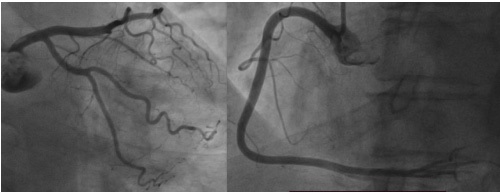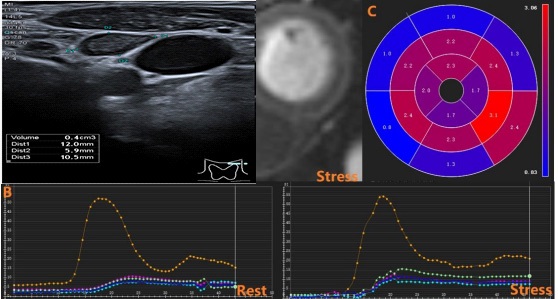
Journal of Clinical Images and Medical Case Reports
ISSN 2766-7820
Case Report - Open Access, Volume 3
The effect of shexiang tongxin dropping pill on coronary microvascular dysfunction assessed by stress perfusion cardiac magnetic resonance: A case report
Jing Wen Yong#; Jin Fan Tian#; Xian Tao Song*
1 Department of Cardiology, Beijing Anzhen Hospital, Capital Medical University, China.
2 #Equal contribution.
*Corresponding Author: Xian Tao Song
Department of Cardiology, Beijing Anzhen Hospital, Capital Medical University, Chaoyang District,
Anzhen Road No.2, Beijing city 100029, China.
Email: songxiantao0929@qq.com
Received : Mar 10, 2022
Accepted : Mar 30, 2022
Published : Apr 06, 2022
Archived : www.jcimcr.org
Copyright : © Tao Song X (2022).
Abstract
Although Coronary Microvascular Dysfunction (CMVD) is clinically prevalent, its therapeutic efficacy data remains uncertain. We report a 62-year-old female CMVD patients whose condition improved after Shexiang Tongxin dropping pill treatment, as confirmed by stress perfusion cardiac MRI. This case emphasizes that Shexiang Tongxin dropping pill is typically effective in the treatment of CMVD. It can not only alleviate symptoms, but also ameliorate microvascular function. Traditional Chinese medicine is a good choice for the treatment of microvascular angina.
Keywords: Coronary microvascular dysfunction; Microvascular angina; Shexiang tongxin dropping pill; Stress perfusion cardiac magnetic resonance; Case report.
Citation: Yong JW, Tian JF, Song XT. The effect of shexiang tongxin dropping pill on coronary microvascular dysfunction assessed by stress perfusion cardiac magnetic resonance: A case report. J Clin Images Med Case Rep. 2022; 3(4): 1779.
Introduction
With the development of imaging technology, CMVD has attracted more and more attention [1]. The mortality of CMVD patients was 3.93 times higher than that of normal people, and the incidence of adverse cardiovascular events was 5.16 times higher [2]. In the past five years, seven related guidelines and expert consensus have been issued one after another [3-9]. However, the treatment of CMVD is still limited to controlling the traditional risk factors of atherosclerosis, improving lifestyle and alleviating the symptoms of angina pectoris [4]. The results of large sample randomized clinical trials with CMVD are still lacking. We found that traditional Chinese medicine is an effective method to treat CMVD in clinical treatment. The purpose of this study is to provide evidence for a new treatment scheme for CMVD.
Case presentation
A 62-year-old woman (165 cm 72 kg) presented with chest tightness and chest pain for 8 months. It used to mainly occur under the sternum radiating to back pain during fatigue, activity, lasting for 1-10 minutes each time, which can be relieved after rest. No history of smoking or drinking. No history of depression and anxiety. She was menopausal at 45 years old. For 5-year history of hypertension, she took irbesartan and diltiazem for reducing blood pressure, and her blood pressure was controlled at 130-140/80-85 mmHg. For 8-years history of hyperlipidemia, she took rosuvastatin for treatment (LDL-C was controlled at 1.26-2.34 mmol/l).
Investigations
The electrocardiogram showed abnormal changes in ST-T (ST-T segment depression in V3-V5) (Figure 1). Echocardiography showed that the structure and function of the heart were normal (EF 63%; LVEDD47; LVESD30). Invasive coronary angiography showed normal coronary arteries (Figure 2). She was diagnosed with non-obstructive coronary ischemia. Cardiac MRI stress myocardial perfusion revealed an area of reduced perfusion in the left ventricle under the endocardium and abnormal Myocardial Perfusion Reserve Index (MPRI) (1.76, normal >2.0) (Figure 3). These findings are consistent with the diagnosis of microvascular angina. The cardiologist gave Shexiang Tongxin Dropping Pills (2 TID).
Follow up
At 1 month, the symptoms improved significantly, the number of attacks decreased, and he was able to work normally (Table 1). At 6 months, the patient had no chest discomfort for 1 month. Re-examination of stress myocardial perfusion cardiac MRI showed an area of perfusion defect in the left ventricle under the endocardium and a decreased MPRI (1.97). At 12 months, she had only two minor chest pains during housework in the past 6 months, and the degree of chest pain was lessened than before. Re-examination of stress myocardial perfusion cardiac MRI showed few perfusion defects in the left ventricle under the endocardium and a normal MPRI (2.41).
Table 1: Follow up.
Follow up |
baseline |
1-month |
3-month |
6-month |
12-month |
MPRI SAQ |
1.75 |
/ |
/ |
1.97 |
2.41 |
Physical |
71.11 |
75.56 |
80 |
80 |
80 |
Angnia |
25 |
75 |
100 |
100 |
100 |
Angnia |
40 |
90 |
90 |
90 |
100 |
Treatment |
41.18 |
94.12 |
64.71 |
88.24 |
94.12 |
Disease |
50 |
83.33 |
100 |
75 |
100 |
LDL-C |
1.26 |
|
1.39 |
1.87 |
2.34 |
CRP |
0.54 |
|
0.82 |
0.75 |
0.48 |
Discussion
Although the 2020 European Expert Consensus provided guidance on the diagnosis and treatment of CMVD [4], there remains great challenges in the management of patients with microvascular angina. Some patients with CMVD were not effectively treated because they did not have obstruction in the epicardial coronary artery. On the other hand, the choices of drugs 4 for CMVD are still very controversial. The 2019 European Guidelines for Chronic Coronary Syndrome [9] and the 2020 European expert consensus [4] inproposed that Angiotensin Converting Enzyme Inhibitor (ACEI), Calcium Channel Blockers (CCB), β-blockers, statin and Renault oxazine can be selected for the treatment of CMVD, and nitrates and Nitrate drugs are used as second-line drugs. The 2017 China expert consensus recommends Nicorandil as the drug of choice, and ranolazine and ivabradine can be used as alternative treatments [3]. However, these drugs cannot solve all the problems
We found in clinical practice that traditional Chinese medicines such as Shexiang Tongxin Dripping Pills is good choices. The mechanism may be related to the increase in endogenous nitric oxide production and the decrease in leukocyte adhesion [10,11]. Moreover, Shexiang Tongxin Dropping Pills can improve CMVD through anti-inflammatory, anti-apoptotic, and anti-oxidant mechanisms [12,13].
Declarations
Acknowledgement: Thank you very much for patient’s willingness to share her experience.
Statement of ethics: We have obtained written informed consent from participants to publish the details of their medical cases.
Conflict of interest statement: None.
Funding sources: This work was supported by Capital Health Development Research Project (No. 2018-2-2063), coronary artery microvascular disease innovation foundation (NO. 2018-CCA-CMVD-01), National Natural Science Foundation of China (NO. 82100486 and 81971569), and Beijing Municipal Science and Technology Project (Z161100000516139).
Author contributions: Jingwen Yong and Jinfan Tian were responsible for the writing of the draft article and the follow-up of patients. Song Xiantao revised the article.
Data availability statement: All the data used are presented in the article.
References
- Huang Q, Wang W, Wang S, Pei A, Sui X. Cardiovascular magnetic resonance image analysis and mechanism study for the changes after treatments for primary microvascular angina pectoris. Medicine. 2021; 100: e26038.
- MA G, VL M, M D, AG M-G, R S, DL B. Association of Isolated Coronary Microvascular Dysfunction With Mortality and Major Adverse Cardiac Events: A Systematic Review and Meta- 5 Analysis of Aggregate Data. Journal of the American Heart Association. 2020; 9: e014954.
- Basic research group cb, Chinese Medical Association, Interventional cardiology group cb, Chinese Medical Association, Female heart health group cb, Chinese Medical Association, Atherosclerosis and coronary heart disease group cb, Chinese Medical Association. Chinese experts’ consensus on the diagnosis and treatment of coronary microvascular diseases. Chinese Circulation Journal. 2017; 32: 421-430.
- V K, A C, PG C, C B, J E, AHEM M, et al. An EAPCI Expert Consensus Document on Ischaemia with Non-Obstructive Coronary Arteries in Collaboration with European Society of Cardiology Working Group on Coronary Pathophysiology & Microcirculation Endorsed by Coronary Vasomotor Disorders International Study Group. European heart journal. 2020; 41: 3504-3520.
- H S, A S, J T, C B, PG C, F C, et al. Clinical characteristics and prognosis of patients with microvascular angina: an international and prospective cohort study by the Coronary Vasomotor Disorders International Study (COVADIS) Group. European heart journal. 2021; 42: 4592-4600.
- T P, O M, R B, J C, E C, G DL, et al. ESC Working Group on Coronary Pathophysiology and Microcirculation position paper on ‘coronary microvascular dysfunction in cardiovascular disease’. Cardiovascular research. 2020; 116: 741-755.
- Society CDBoCG. Chinese Multidisciplinary Expert Consensus on the Clinical Diagnosis and Treatment of Microvascular Diseases. Chinese Circulation Journal. 2020; 35: 1149-1165.
- JE T-H, H J, HR R, S A, ES B, TM B, et al. Contemporary Diagnosis and Management of Patients With Myocardial Infarction in the Absence of Obstructive Coronary Artery Disease: A Scientific Statement From the American Heart Association. Circulation. 2019; 139: e891-e908.
- J K, W W, A S, D C, E B, C F-B, et al. 2019 ESC Guidelines for the diagnosis and management of chronic coronary syndromes. European heart journal. 2020; 41: 407-77.
- Zhang Yanda SS, Li Na, He Zhiqing, Wu Zonggui and Liang Chun. The mechanism of Shexiang Tongxin dripping pills in improving microcirculation in mice with myocardial infarction. Journal of Integrated Traditional Chinese and Western Medicine CardioCerebrovascular Disease. 2017: 2969-2972.
- Yu Siyao ZH, Yan Qunzhao, Tu Dili, Yuhong Liu and Rong Chen. Shexiang Tongxin dripping pills improve coronary microcirculation and cardiac function after myocardial ischemia reperfusion in pigs. Journal of Southern Medical University. 2020; 40.
- Ding Y, Zhu HY, Zhang LZ, Gao BB, Zhou L, Huang JY. Shexiang Tongxin Dropping Pill Reduces Coronary Microembolization in Rats via Regulation of Mitochondrial Permeability Transition Pore Opening and AKT-GSK3β Phosphorylation. Chinese Journal of Integrative Medicine. 2020: 1-7.
- Liu H, Zhao J, Pan S, Zhu Y, Peng F. Shexiang Tongxin dropping pill protects against sodium laurate-induced coronary microcirculatory dysfunction in rats. Journal of traditional Chinese medicine: English Edition. 2021: 41: 9.



